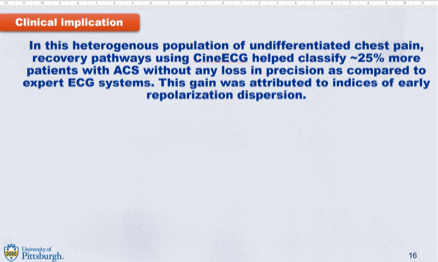Best in class 12 -lead ECG interpretation support for medical professionals
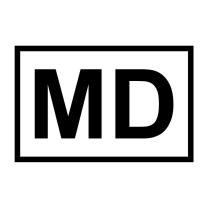
Professional users only
Rooted in Science
Only requires standard ECG data
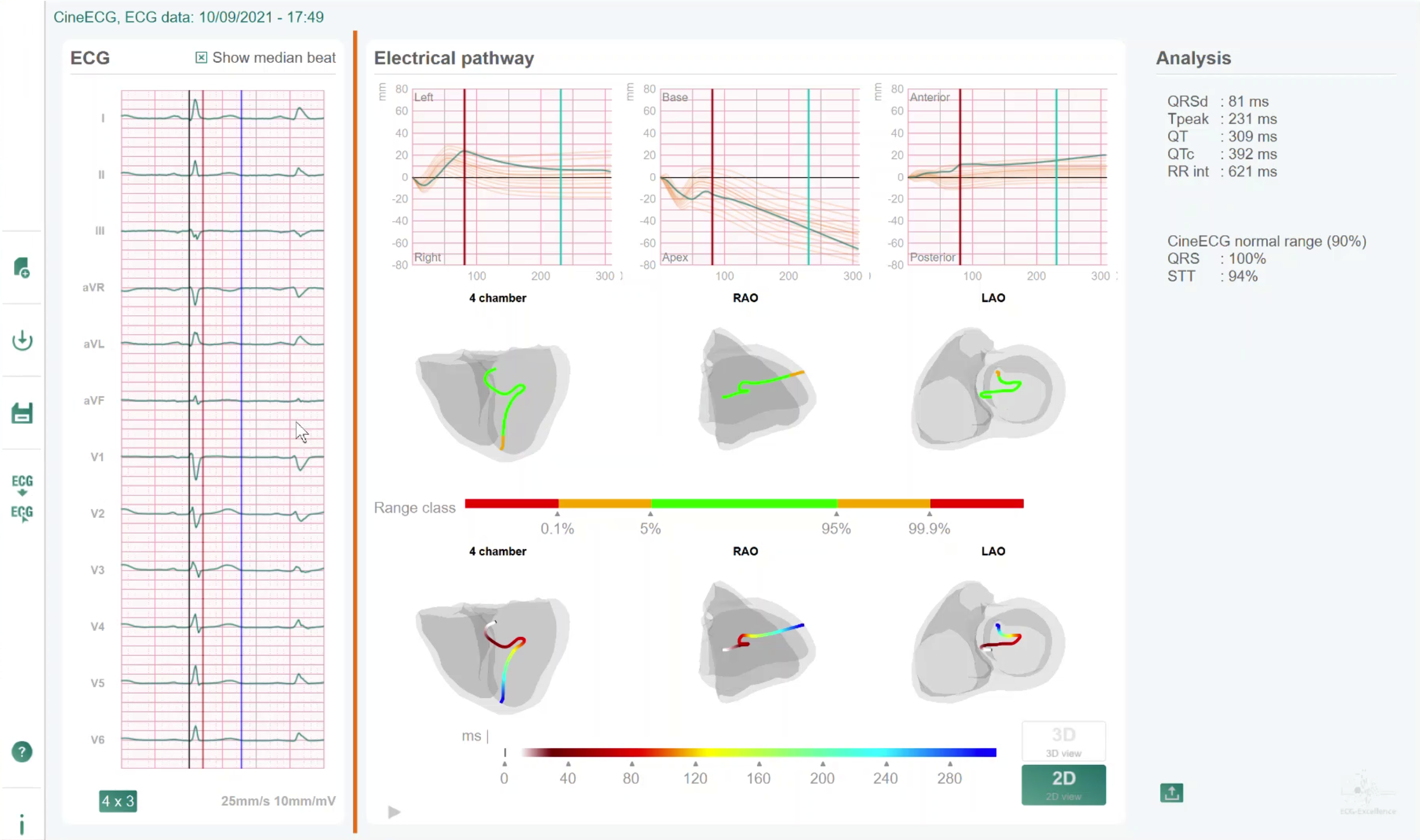
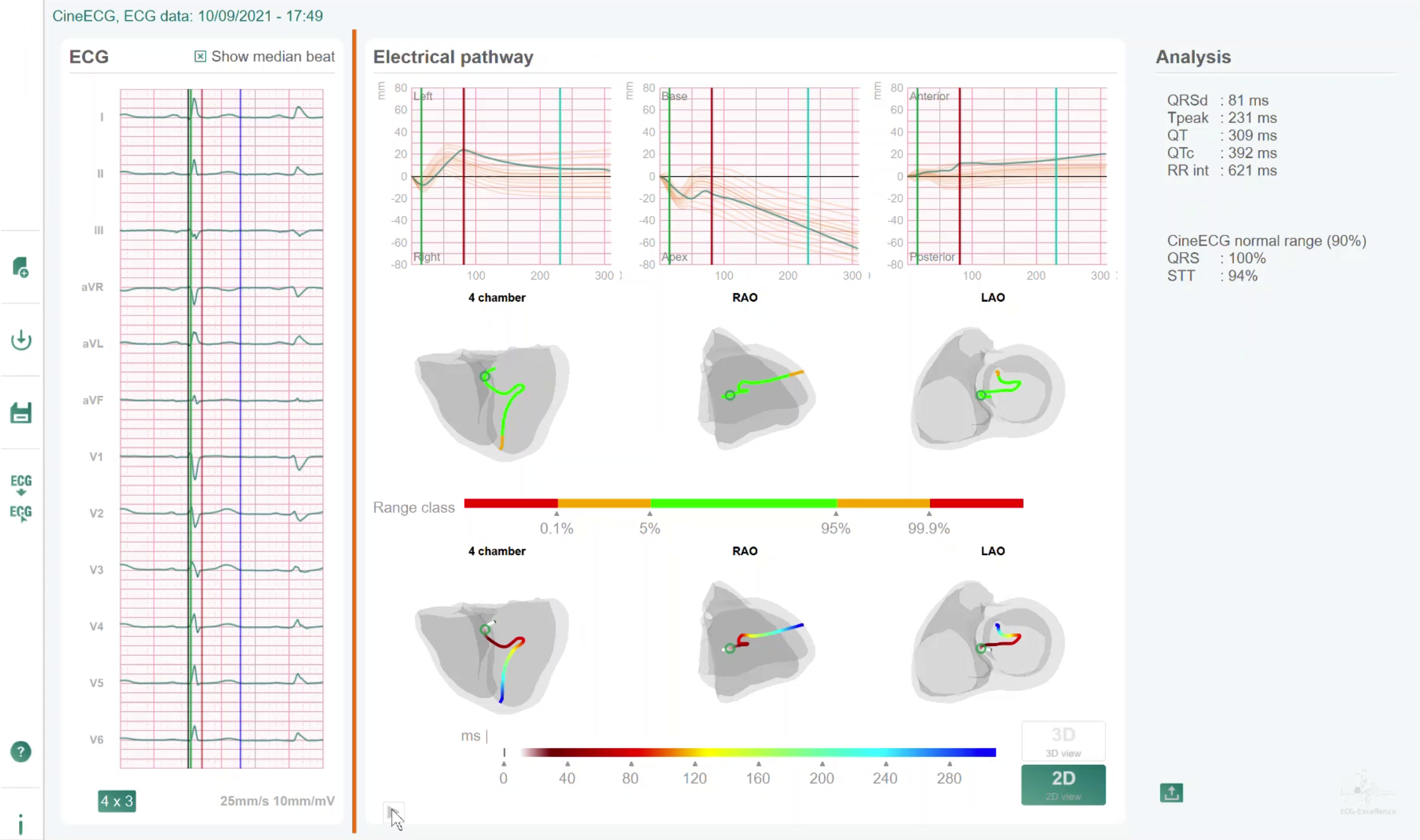
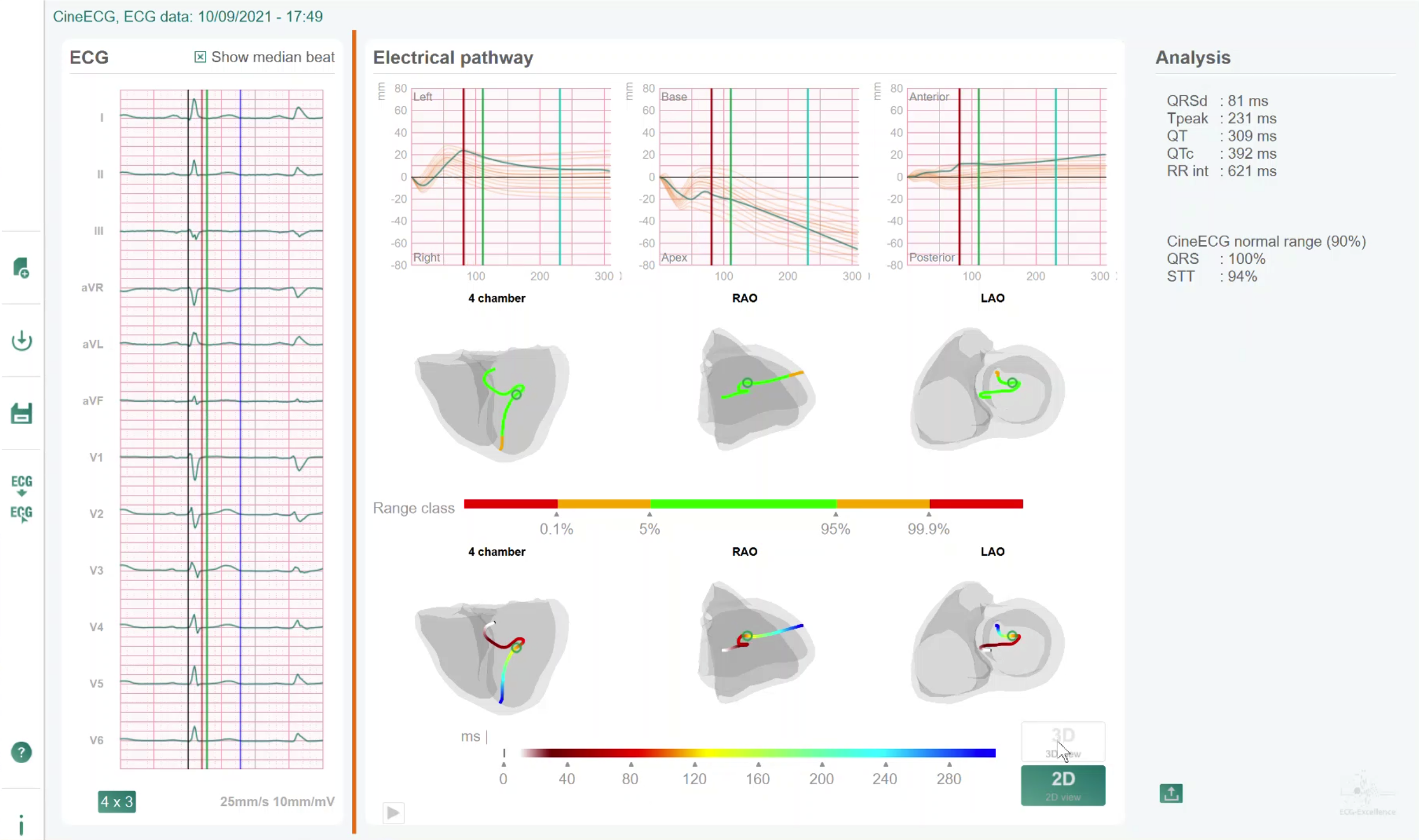
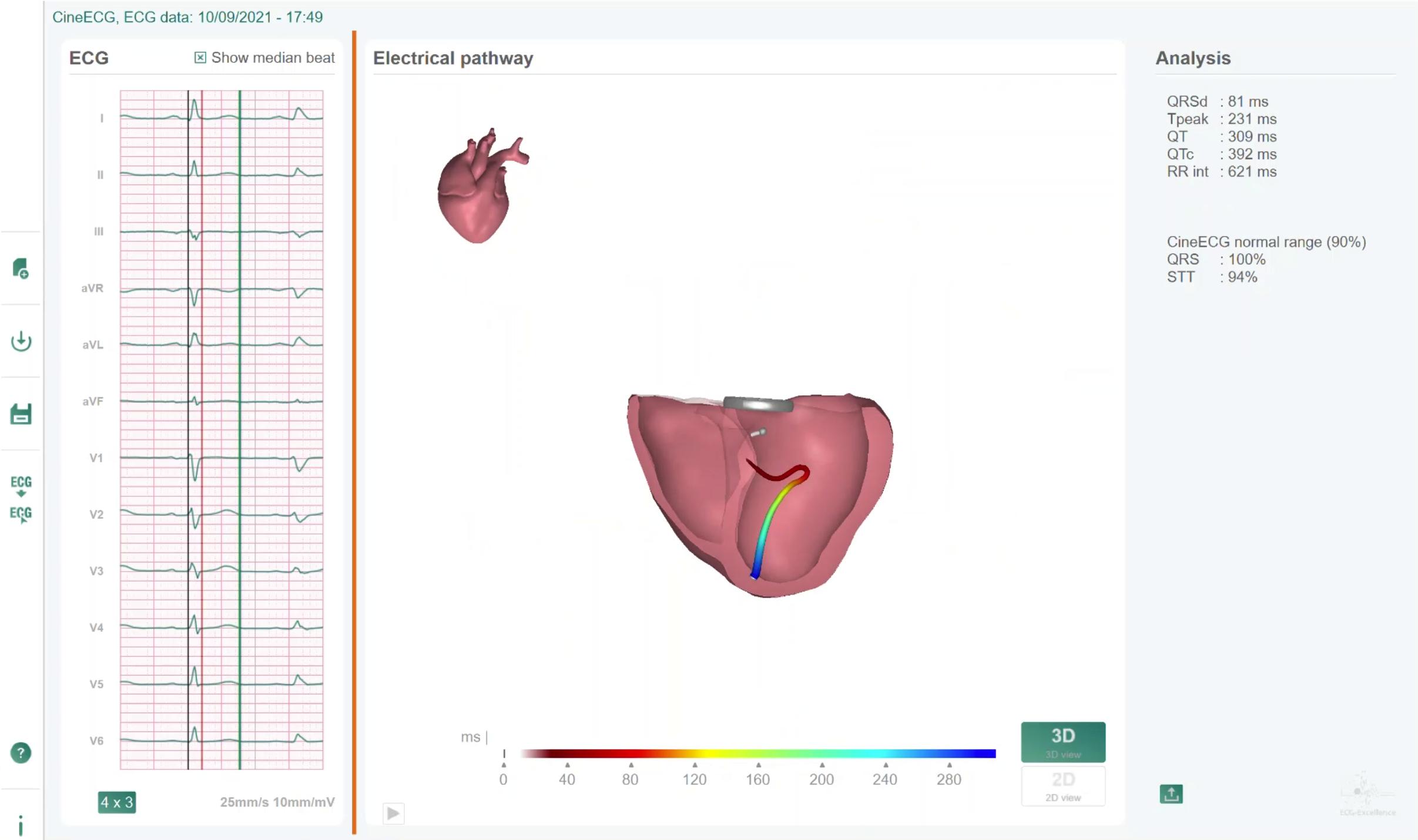
CineECG Insights
Academic recognition for CineECG
We have a winner with CineECG
CineECG classifies +25% more patients with ACS
CineECG: outperforming existing ECG expert systems
Example report
Page 1 of the report is the familiar 4 * 3 ECG presentation including a listing of key heart rate and heart rhythm parameters. Plus results Path and Wave ECG comparision against normal
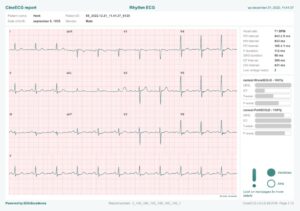
Page 2 shows the median beat derived from the 12-lead ECG on the left side of the page.
On the upper side of page 2 the delta wave map view of the recorded amplitudes is presented. The recorded amplitudes are compared against a normal distribution of ‘normal’ ECG amplitude characteristics. Only in case of a relevant deviation against normal the graphs shows a deviation from a flat line. On the upper right side of the page the percentages of the amplitude comparison against normal are listed for the QRS, ST segment and T wave
On the lower side of page 2 the Path ECG is shown. This shows the mean activation of the heart related to the heart anatomy. The comparison against normal is visualized in these graphs by showing the recorded value combined with the normal distribution of ‘normal’ CineECGs. On the right again the percentages of this comparison for QRS, ST segment and T wave.
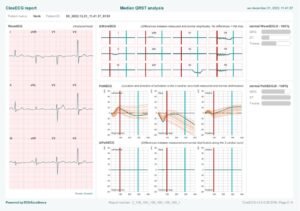
On page 3 the path ECG of the Ventricular is presented in a 3D format and in 3 views of the heart .
In the top row the CineECG is colored to reflect the comparison against normal values. For this purpose CineECG uses green, amber and red. In case of red the mean activation deviates from normal.
In the lower row the CineECG is colored to reflect the timing of the activation.
This row also shows the reflection of the normal CineECG path in the white shadow line in these visualisations.
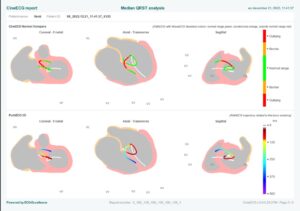
Page 4 focuses on the Atria and the P wave analysis.
On the left side it shows the median beat derived from the 12-lead ECG on the left side of the page.
On the upper side of page 4 the path ECG of the Atria is presented and the results of the comparison against normal values is presented in both the 2D graphs and the percentage bars on the right side.
On the lower side of page 2 the Path ECG in the Atria is shown in 3D format. This shows the mean activation of the heart related to the heart anatomy.

On page 5 provides additional information regarding the content of the CineECG report, a detailed description of the content of each page, an explanation on the models which are used. Page 5 also contains information regarding the manufacturer of CineECG and a link to the website and instructions for use
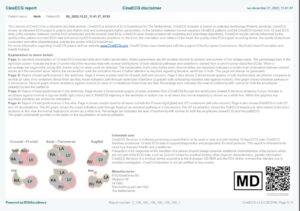
Learn from others before you
Frequent Asked Questions (FAQ)
Your questions might have already been answered in the following categories.
There are 2 options for registration:
- Sign up for our newsletter (name, email, telephone number)
- Send us your contact data (name, email, organisation) to request a CineECG report and analysis on your ECG data (this if for medical professionals only)
Please send an email to info@cineecg.com
or click on unsubscribe in the newsletter email
Yes, we will only correspond to you through the newsletter emails and newsletter attachments. Your data will not be shared with other organisations.
At this moment you can not upload your ECG data direct to receive a CineECG report. CineECG data processing is only available through the platforms of our trusted partners.
For a test to check if your ECG data can be converted at this moment to obtain a CineECG analysis you can upload digital 12 lead ECG data sets in the following formats:
ISHNE
DICOM
FDA HL7
For other output formats please contact us via info@ecg-excellence.com
SCP
Schiller XML
AMPS binary
AMPS xml
CardioCalm XML
At this moment this is not possible. Only digital ECG data formats are accepted by our system. In future we intend to provide a PDF to Digital conversion service.
CineECG analysis is not based on interval measurements (rule based) but on ECG morphology analysis. The main CineECG principle is to compare recorded ECG with normal ECG values.
The CineECG adds the direct relation between the standard 12 lead ECG and the cardiac anatomy. This provides a novel anatomical view on the ECG. We also compare the results of the CineECG analysis to normal distribution of CineECG values for normal healthy heart performances. The comparison with normal is also applied with the ECG waveform (all 12 leads).
The comparison is presented categorized in P wave, QRS, ST segment and T-wave.
In this section you will find the standard visual presentation of the uploaded ECG data in 12 graphs. You will also find a standard number of numeric values derived from the uploaded data regarding interval measurement analysis (Heart Rate, RR, NN, P duration, QRS duration, QT, QTc )
For a detailed description we refer you to the tutorials section where you can find a document with the description of the information provided in the report.
The origin of the normal CineECG output is a public ECG data set: Wagner P, Strodthoff N, Bousseljot RD, Kreiseler D, Lunze FI, Samek W, et al. PTB-XL, a large publicly available electrocardiography dataset. Sci Data. 2020;7(1):154.
The process which we have followed in deriving the normal CineECG’s has been published in an article: van Dam PM, Boonstra M, Locati ET, Loh P. The relation of 12 lead ECG to the cardiac anatomy: The normal CineECG. Journal of Electrocardiology. 2021;69:67-74.
The CineECG changes its location over time within the cardiac space. The CineECG locations have been determined for 6500 normal ECGs of the PTB XL database, thereby setting boundaries for normal CineECG locations. When the CineECG stays within this “normal cardiac space” the CineECG is conform these normal locations.
The normal distribution applied is corrected for outliers and the normal range is within the 95% statistical range.
For a detailed description we refer you to the tutorials section where you can find a document with the description of the information provided in the report.
The CineECG report is only available in PDF format for download purposes. In the VIEW mode the report is presented as a PDF on screen.
CineECG has been validated through a growing number of scientific studies. For these studies we used a retrospective approach and used ECG data sets which have been qualified.
All the CIneECG validation stems from collaborations between ECG Excellence and teams of expert universities in Europe and the USA.
The validation regarding the normal CineECG values has been conducted by using a public available ECG database.
All publications underpinning the validation of CIneECG have been published in peer to peer reviewed scientific journals. A list of scientific articles is available on the cineecg.com website (about page)
CineECG validation is an ongoing journey. Every new ECG data set adds further value to the validation process and the tuning of the algorithms. CineECG is a result of earlier R&D regarding the use of computerized modelling to create simulations of a persons cardiac activation and recovery processes. The process of computerized modelling and especially the inverse variant in modelling has its roots in Dutch universities. During the past century this work has started and has resulted in ever improving computerized models of heart and torso to understand cardiac activation and the impact of tissue conduction, tissue quality and skin positions of electrodes.
The team behind CineECG has continued this journey and has found solutions to relate ECG data to the heart anatomy and has developed algorithms to show electrical pathways through this anatomy. The scientific base for the CineECG technology is extensive and if you are interested we advice you to download the R&D portfolio summary on the “about” page.
The history of CIneECG dates back at least 15 years and todays result has been achieved by collaboration with a number of organisations:
- University Medical Center Utrecht
- IRCCS Policlinico San Donato Milanese
- Radboud University Nijmegen
- Basel University Hospital
- HochSchule Lucern
- Peacs BV
- Dutch Heart Foundation
- Health Holland.
- Eureka/Eurostars innovation support
At this moment CineECG has been tested for a limited number of cardiac disorders. Testing the added value of CineECG in detecting additional cardiac disorders is proceeding on a ongoing base. However the current version of CineECG is RESEARCH ONLY. The CIneECG report only shows the level of conformity between normal values and the recorded values.
You can find information in our R&D portfolio which can be downloaded on the ”about” page.
Please contact our team via the request further information box or send an email to info@cineecg.com.
At this moment in time CineECG is not CE MDR certified. The current version of CineECG is only available for research purposes.
CineECG is in the process of being qualified for a CE MDR certification class IIa. This is needed for providing diagnostic feedback in the next versions of CineECG.
The company ( ECG Excellence) supporting and developing CineECG is ISO13485 certified systems.
Our support is delivered by answers provided in a) these FAQ section of our CineECG website; b) in the tutorials which are also made available through this website (at this moment the tutorials are in PDF format but we will add video based explanations of the key CIneECG processes in the near future, c) we also offer the CineECG Demonstrator as an application to experience the power of CineECG in ECG interpretation yourself and d) by contacting our team via the dialogue box provided on the website or via sending an email to info@cineecg.com.
We will either respond to you by email or if this is needed we will contact you for a bilateral conversation in which we can assist you even better.
by contacting our team via the dialogue box provided on the website or via sending an email to info@cineecg.com.
We will either respond to you by email or if this is needed we will contact you for a bilateral conversation in which we can assist you even better.
Please contact our team via the dialogue box in CineECG.com
We are trying to answer all information requests within 48 hours in normal work days. If you send us a question during the weekend this response time may be a little longer.
The scientific base of CineECG and the domain of added value is constantly challenged and enlarged by our team. We expect to use CineECG for identification of more conduction related cardiac disorders both in the atria and the ventricles.
We are also planning to launch desktop and or Hospital Information System versions which will provide more functionality to users of CineECG. The interactive version of CineECG may support comparing CineECG’s from a same patient, beat selection-based analysis, selecting between 3D and 2D views, zooming function to explore more details. We also aim to work to a more patient specific solution of CineECG incorporating 3D photo derived information on the patient.
Yes, ECG Excellence has embarked on a mission to improve the ECG interpretation through digital twin-based technologies. A next step in this approach is to further increase the personalisation of the data collection and data processing. In order to achieve this, we are developing a technology which can easily capture the actual ECG electrode positions on the torso and derive the heart orientation from physical characteristics of the torso.
The vision guided ECG recording technology will also contain an ECG electrode positioning support facility which will show the operator where to place the electrodes on the torso, taking a person’s physical characteristics into account. Or apply a disease specific electrode configuration. This system will also support re-positioning of ECG electrodes at the same locations during a next ECG recording session.
Please contact our team via the dialogue box in CineECG.com
Please contact our team via the dialogue box in CineECG.com
Please contact our team via the dialogue box in CineECG.com
Ask for a demo of CineECG or forward another question
We are ready to show you how CineECG can help you evaluating a patients heart performance. Do not hesitate to submit your question or demo request
and we will answer as soon as possible.


